
- •Lesson (1) Chromosomes and genetic information
- •Remember
- •Remember
- •Importance of crossing over:-
- •Lesson (2) The interaction of genes
- •Remember
- •Remember
- •Inheritance of blood groups in human
- •For illustration only
- •Inheritance of colour trait in mice
- •Inheritance of chlorophyll absence trait in corn plant
- •Lesson (3) Genetic inheritance and diseases
- •Importance of pedigree
- •Answer four questions only
Inheritance of colour trait in mice
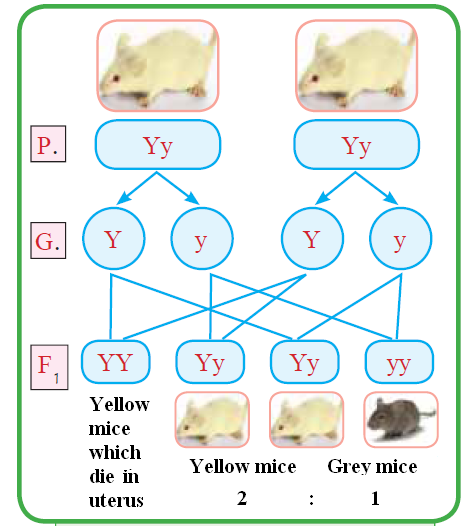
When two hybrid yellow mice copulate, the
ratio of product generation is 1:2.
Pure yellow mice die because they carry
pure lethal dominant pair of gene (YY) which
causes the death of mice in uterus.
These results contradicts with Mendel's first
law of the segregation of factors because when
two hybrid yellow mice copulate, they produce
yellow and grey mice at ratio 3:1 according
to Mendel's first law, while they produced
yellow and grey mice at ratio 2:1
The ratio of dead yellow mice is 25% of
the product generation
Inheritance of chlorophyll absence trait in corn plant
When some corn plants self-pollinate, they produce white seedlings which don't have chlorophyll . These seedlings grow for a short time, then they wither and die. This happens because of a pure recessive lethal gene (cc)
When two recessive lethal genes aggregate together in some individuals, chlorophyll will not be formed in them. Chlorophyll gives the plant its green colour and it is responsible for absorbing light rays to carry out photosynthesis process.
Plants carrying (cc) pair of genes are white and not able to perform photosynthesis process which causes their death.
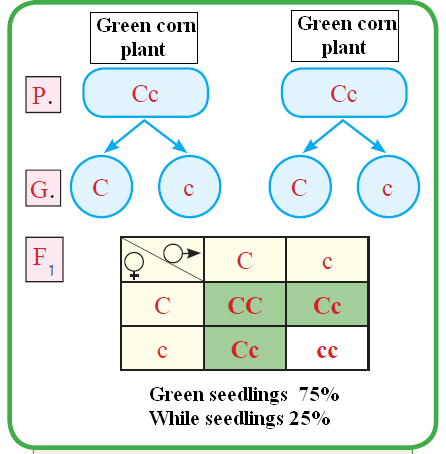
![]()
The work of some genes is affected by the factors surrounding living organisms (Ex. Air pollutants – lack of oxygen – radiation) and environmental factors (Ex. Light – temperature).
The study of factors affecting genes help us avoid the risks resulted from them.
The effect of absence of light on chlorophyll trait in green plants
The gene responsible for chlorophyll formation in green plants needs light factor, so that the effect of gene appears.
Green plant cannot form chlorophyll if the gene responsible for it is absent, even if it was put in light
![]()
Lack of dominance: A form of inheritance in which no genes dominate over the other one, but they interact forming new trait
Antigens: They are chemical substances which exist on the surfaces of red blood cells, they play an important role in blood transfusion process.
Antibody: They are antibodies of antigens which exist in blood plasma, they play an importance role in blood transfusion process
Rhesus factor: A kind of antigens which exists on the surfaces of red blood cells of most humans, its inheritance is controlled by three pairs of genes which are carried on one chromosome pair.
Complementary genes: Genes which interact with each other causing the appearance of a hereditary trait.
Lethal genes: Genes which obstruct growth and cause death at different ages when they exist in pure (homozygous) form
![]()
1- When two individuals different in one pair of hereditary traits copulate, the second generation ratio is 1:2:1 not 1:3
Because the genes of those different traits do not dominate over each other. So, they interact with each other forming new trait, which appears in 2nd generation with the two opposite traits at ratio 1:2:1 (not 1:3 – as Mendel laws state – because of the lack of dominance)
2- The importance of blood groups
Because they :-
- Solve problems of the determination of paternity (parents of children) and pedigree of children (blood groups denies pedigree but don't prove it)
- Determine blood transfusion processes between individuals.
- Are used in the study of human races classification and evolution
3- Blood group (O) is a universal donor, while blood group (AB) is a universal recipient
Blood group (O) is a universal donor because it has both antigen-a and antigen-b and doesn't have any antibodies, which makes it capable of giving blood to all groups. While blood group (AB) is a universal recipient because it has both anti-a and anti-b and doesn't contain any antigens, which makes it capable of receiving blood from all types.
4- Giving blood of inconvenient group to a recipient person is very dangerous.
Because giving blood to a person of a blood group unsuitable for his blood causes the break of red blood cells, which cause sickness, chest pain, irregular heartbeat, blueness, headache, and even death!!
5- Blood should be examined before transfusion process
To make sure it is convenient for the blood of recipient person and doesn't contain any disease-causing organisms (Ex. Viruses)
6-The importance of determination of rhesus factor in blood
Because it is very important to determine it before blood transfusion process and marriage; in order to prevent the formation of antibodies of Rh factor antigens, which breaks red blood cells.
7- Woman who was pregnant with a baby of different rhesus factor should take vaccine within 72 hours after every delivery
To break up the amount of blood mother had taken from her first fetus – which contains Rh+ - before her immune system forms Rh antibodies. Which protects her second fetus.
8- Inner cabbage leaves are not green-coloured
Because the gene responsible for chlorophyll formation in green plants (which give them its green colour) needs light; so that its effect will appear. But we find that inner cabbage leaves are not exposed to light.
![]()
1- Transfusing blood from a man of group (AB) to another one of group (A)
This will break red blood cells of the recipient person because his blood produces anti-b for antigens-B of blood group (AB), which causes shivering in body, chest pain, blueness, irregular heartbeat, headache, low blood pressure
2- (Rh-) woman married (Rh+) man (with respect to the first and second babies)
When the woman becomes pregnant with the first baby (which is Rh+), a part of his blood transfers from him to his mother, which stimulates her immune system to produce antibodies of Rh factor antigens. If mother wasn't given vaccine after delivery of the first baby, and became pregnant again with another baby, Rh+ blood transfers from mother to her second baby through placenta, which breaks up his red blood cells and causes him acute anemia and even death.
3- Two sweet pea plants with white flowers whose genotypes are (aaBB) and (AAbb) copulate (first and second generations)
100% pink flowers are produced in the first generation, while both pink and white flower appear in the second generation at ratio 9:7
4- Breeding two yellow mice (Yy)
H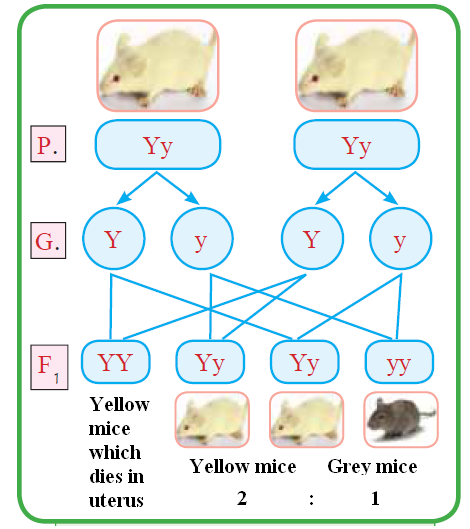 ybrid
yellow and black mice are produced at ratio 2:1 respectively, pure
yellow mice (YY) - which represent 25% of the generation – die in
uterus before being born.
ybrid
yellow and black mice are produced at ratio 2:1 respectively, pure
yellow mice (YY) - which represent 25% of the generation – die in
uterus before being born.
5- Planting corn plant seedlings in a dark place
Seedlings lose their green colour due to the lack of chlorophyll, as the gene responsible for chlorophyll formation is activated only by light (which is absent)
![]()
1- Choose the correct answer
1- in lack of dominance case, the ratio of 2nd generation resulted from the copulation of two individuals different in one pair of opposite traits is ………..
A- 1:3 B- 1:2:1 C- 7:9 D- 1:2
2- When a man of blood group (AB) marries a woman of blood group (O), the ratio of children which have blood group (O) is ……..
A- 0% B- 50% C- 25% D- 75%
3- Blood group which has both types of antigens is……
A- A B- O C- AB D- B
4- Blood group which has both types of antibodies is…..
A- A B- O C- AB D- B
5- Blood group which is known as "Universal recipient" is
A- A B- O C- AB D- B
6- Blood group which is know as "Universal donor" is……
A- A B- O C- AB D- B
7- Trait of flower colour of sweet pea plant is an example on ……….
A- Lack of dominance B- Alleles multiplicity C- Complementary genes
D- Lethal genes
8- The inheritance yellow mice colour is an example on ………….
A- Lack of dominance B- Alleles multiplicity C- Complementary genes
D- Lethal genes
9- ……… gene is an example on recessive lethal genes
A- Yellow colour of mice B- Infantile dementia C- Turner's syndrome
D- Bulldog race in cow
10- ….. is an example on dominant lethal genes
A- Yellow colour of mice B- Infantile dementia C- Turner's syndrome
D- Bulldog race in cow
2- Write the scientific term
1- A form of inheritance in which no genes dominate over the opposite one, but they interact forming new trait
2- chemical substances which exist on the surfaces of red blood cells, they play an important role in blood transfusion process.
3- A kind of antigens whose inheritance is controlled by three pairs of genes which are carried on one chromosome pair.
4- Genes which interact with each other causing the appearance of a hereditary trait.
5- Genes which obstruct growth and cause death at different ages when they exist in pure (homozygous) form
3- Write short notes about:-
1- Dangers of blood transfusion
2- Rhesus factor
3- Lethal genes
4- Complementary genes
4- Compare between
1- Blood types (A) and (B)
2- Lethal and complementary genes
5- Rationalize the following cases on a genetic basis
1- A man of blood group (A) married a woman of blood group (B) and bore a child of blood group (O)
2- A woman whose blood group is (AB) has a son of the same blood group, what are the probable genotypes of the father?
3- Breeding four o'clock plant with red flowers with another one of pink flowers.
6- The following table illustrates the generation resulted from the breeding of two sweet pea plants, then answer the following questions

1- What are the genotypes of (1), (2), (3), (4)
2- Find the genotypes of the parents
3- What is the percentage of white flowers in this generation?
4- What is the colour of flowers produced from the breeding of plant (4) with (3)
7- If your blood group is (A) and you need blood transfusion, which blood groups are suitable for you? Why?
8- Answer the following question
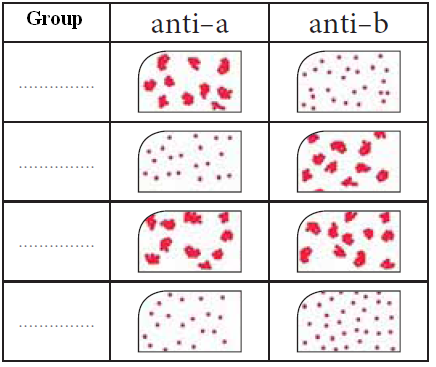
1- Complete the previous table mentioning blood groups
2- Which blood group has both types of antigens?
3- Which blood group has both types of antibodies?
![]()
1- Choose the correct answer
1- 1:2:1 6- O
2- 0% 7- Complementary genes
3- AB 8- Lethal genes
4- O 9- Infantile dementia
5- AB 10- Yellow colour of mice
2- Write the scientific term
1- Lack of dominance 2- Antigens 3- Rhesus factor
4- Complementary genes 5- Lethal genes
3- Write short notes about:-
1- Giving blood to a person of an inconvenient group causes headache, shortness of breath, chest pain, irregular heartbeat, blueness, shivering in body and usually ends with death. Transfusing polluted blood to a person may cause viral infection (Ex. AIDS – Hepatitis B)
2- Rhesus factor is a kind of antigens which exist on the surfaces of red blood cells of 85% of humans, its inheritance is controlled by 3 pairs of genes which exist on one chromosome pair.
3- Lethal genes are genes which obstruct growth and cause death to living organisms if they are present in pure (homozygous) form. There are recessive lethal genes (such as the genes causing the absence of chlorophyll in corn plants and infantile dementia in humans) and dominant lethal genes (such as the genes of yellow colour of mice and bulldog race in cows)
4- Complementary genes are genes which interact together forming a certain trait. The appearance of this trait is controlled by two pair of genes, there must be at least one dominant gene in each pair so that the dominant trait appears. Otherwise, recessive trait will appear. The flower colour of sweet pea plant is an example of complementary genes
4- Compare between
Blood type (B) |
Blood type (A) |
P.O.C |
BB – BO |
AA – AO |
Genotype |
Anti-a |
Anti-b |
Antibody |
Antigen-b |
Antigen-a |
Antigen |
Blood types (B) and (O) |
Blood types (A) and (O) |
Receives blood from |
Complementary genes |
Lethal genes |
- They are genes which interact together forming hereditary trait
- Ex. Flower colour trait of sweet pea |
- They are genes which obstruct growth and cause death to living organisms if they are present in a pure form
- Ex. Infantile dementia gene in humans |
5- Rationalize the following cases
Case (1)
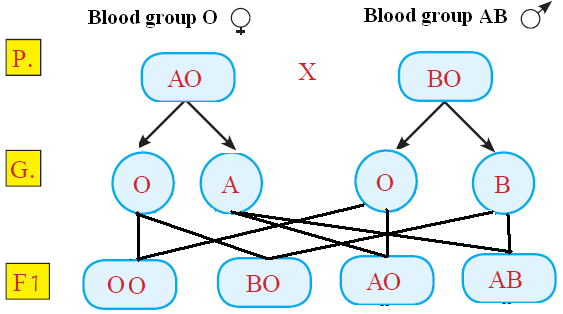
Case (2)
Genes forming blood type (AB) are (A) and (B)
Thus, father should have at least one of those genes in his blood type
Probable genotypes of father are (AO) – (AA) – (AB) – (BO) – (BB)
Case (3)
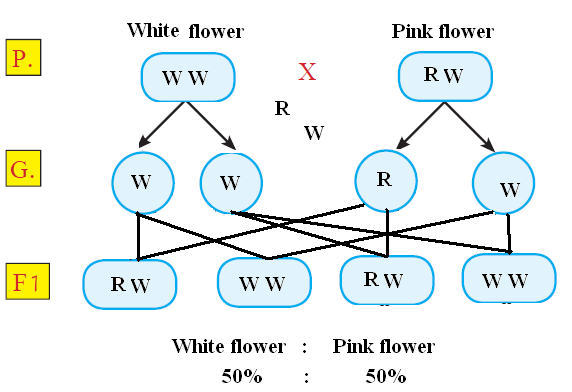
6- The following table illustrates the generation resulted from the breeding of two sweet pea plants, then answer the following questions

1- (1) AABB
(2) AaBB
(3) AABb
(4) AaBb
2- Genotype of 1st parent: AaBb
Genotype of 2nd parent: AABb
3- 25%
4- 75% Pink flowers
25% white flowers
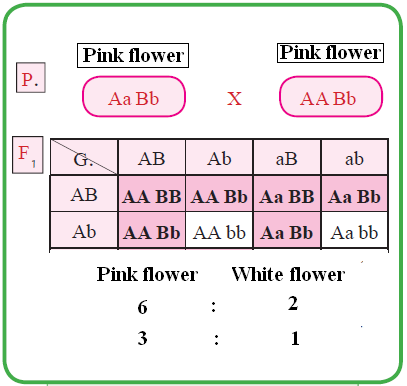
7- Blood of groups (A) and (O) will be suitable because group (A) has antigen-a and anti-b like my own blood group, and (O) group has no antigens and both a-anti and b-anti
8-

2- (AB) group
3- (O) group
